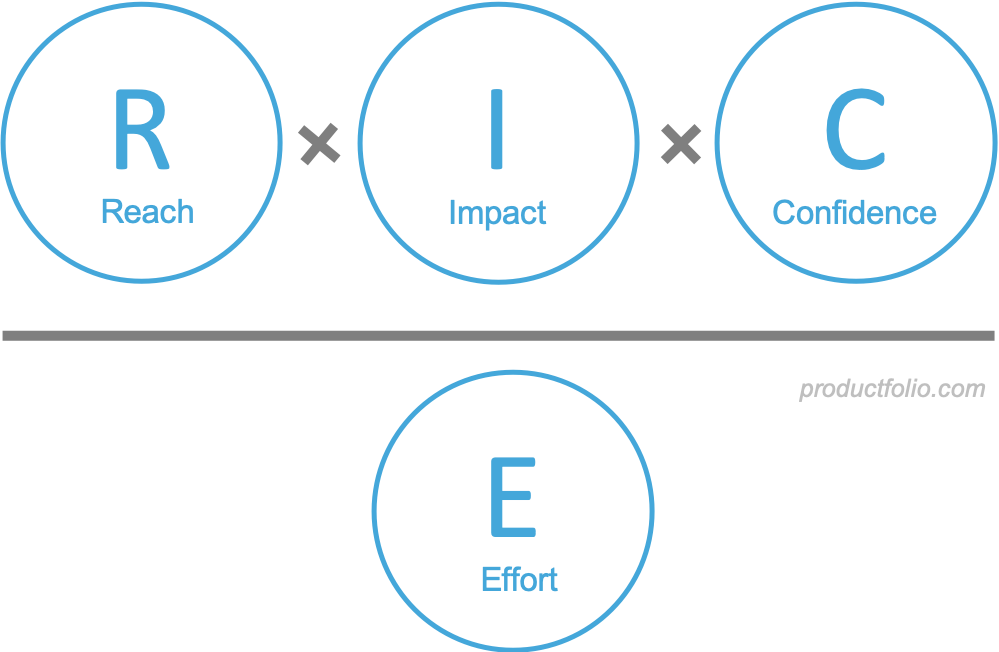The RICE Scoring Model
The RICE Prioritization scoring model is a framework designed to help Product Managers make informed decisions about which products, features, and initiatives to prioritize on their roadmaps. Messaging-software maker Intercom developed the RICE prioritization model to facilitate and improve their team’s decision making power. Intercom’s team had worked with dozens of other prioritization models and were still unable to find one that gave a concrete scoring method to help the team determine which initiatives to prioritize in a clear and concrete manner. Thus, the RICE scoring system was created.
What is the RICE Scoring Model?
RICE is an acronym that stands for Reach, Impact, Confidence, and Effort. By evaluating and scoring each of your competing ideas, you can come up with a concrete number to determine which initiatives should be prioritized and in which order.

Reach – This determines how many people your initiative will reach in a given timeframe. Your specific initiative will determine the context of the reach. From there, determine how long you will monitor this reach and give your “reach” a total score. For example, we expect 1000 people to visit the site in 30 days.
Impact – The number of people that take action on your initiative during the scheduled time frame. For example, from the 1000 people that traffic the site in 30 days, we are expecting 30 people to buy a product. The 30 people are the total measure of impact.
Intercom’s five tier scoring system is helpful in measuring expected impact:
- 3 = massive impact (XL)
- 2 = high impact (L)
- 1 = medium impact (M)
- .5 = low impact (S)
- .25 = minimal impact (XS)
Confidence – Your confidence score is a balanced measurement of the data you have to back up your potential Reach and Impact scores combined with your sense and intuition. For example, your analytics are showing that your traffic based on similar products should reach approx 1000 people in 30 days, and your gut tells you that your new product will get about 30 new buyers.
Intercom also created a scoring method for confidence scores.
- 100% = high confidence
- 80% = medium confidence
- 50% = low confidence
Effort – So far we’ve covered reach, impact, and confidence which all reference a benefit to your product or initiative. Effort however, represents the cost of your initiative. For this reason, it takes a dominant role in determining your overall RICE score. A RICE score is essentially a simplified version of doing a cost-benefit analysis for your initiative or product. To determine your “effort” score you want to take a look at how many people it will take to complete each task and how much time it will take those people. For example, it will take 5 people, 6 months to complete this project. This clarifies and helps to determine your cost as well as your score. Use the same scoring system that was created for Reach.
- 3 = massive impact
- 2 = high impact
- 1 = medium impact
- .5 = low impact
- .25 = minimal impact
Creating a score with RICE
To create your overall RICE score multiply all of your benefits and then divide your costs.
Reach X Impact X Confidence (divided by) Effort = Total Score
For example, average Reach (3) X Average Impact (3) X High Confidence (100%) (5) (divided by) Low Effort (2) = 22.5
Using RICE for Prioritization
Now that you have your total score of 22.5, you can create a RICE score for all of the other initiatives on your roadmap and prioritize them based on the total score. This framework creates and clear and consistent way for teams to objectively prioritize initiatives based on the overall value that they will generate. By creating a scoring system with the RICE scoring model it makes it clear to the whole team what order each initiative should be worked on eliminating competition from the team.